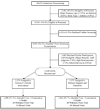Impact of a weight management program on health-related quality of life in overweight adults with type 2 diabetes
- PMID: 19171813
- PMCID: PMC2705948
- DOI: 10.1001/archinternmed.2008.544
Impact of a weight management program on health-related quality of life in overweight adults with type 2 diabetes
Abstract
Background: Inconsistent findings have been reported regarding improved health-related quality of life (HRQOL) after weight loss. We tested the efficacy of a weight management program for improving HRQOL in overweight or obese adults diagnosed as having type 2 diabetes mellitus.
Methods: We conducted a randomized multisite clinical trial at 16 outpatient research centers with 2 treatment arms and blinded measurements at baseline and the end of year 1. A total of 5145 participants (mean [SD] age, 58.7 [6.9] years; mean [SD] body mass index [calculated as weight in kilograms divided by height in meters squared], 36.0 [5.9]; 59.5% women; 63.1% white) were randomized to an intensive lifestyle intervention (ILI) or to diabetes support and education (DSE). Main outcome measures included the 36-Item Short-Form Health Survey physical component summary (PCS) and mental health component summary (MCS) scores and Beck Depression Inventory II (BDI-II) scores. Baseline mean (SD) scores were 47.9 (7.9) for PCS, 54.0 (8.1) for MCS, and 5.7 (5.0) for BDI-II.
Results: Improved HRQOL was demonstrated by the PCS and BDI-II scores (P < .001) in the ILI arm compared with the DSE arm. The largest effect was observed for the PCS score (difference, -2.91; 99% confidence interval, -3.44 to -2.37). The greatest HRQOL improvement occurred in participants with the lowest baseline HRQOL levels. Mean (SD) changes in weight (ILI, -8.77 [8.2] kg and DSE, -0.86 [5.0] kg), improved fitness, and improved physical symptoms mediated treatment effects associated with the BDI-II and PCS.
Conclusions: Overweight adults diagnosed as having type 2 diabetes experienced significant improvement in HRQOL by enrolling in a weight management program that yielded significant weight loss, improved physical fitness, and reduced physical symptoms.
Trial registration: clinicaltrials.gov Identifier: NCT00017953.
Figures





References
-
- Mokdad AH, Bowman BA, Ford ES, Vinicor F, Marks JS, Koplan JP. The continuing epidemics of obesity and diabetes in the United States. JAMA. 2001;286:1195–1200. - PubMed
-
- Ogden CL, Carroll MD, Curtin LR, McDowell MA, Tabak CJ, Flegal KM. Prevalence of overweight and obesity in the United States, 1999–2004. JAMA. 2006;295:1549–1555. - PubMed
-
- Gregg EW, Williamson DF. The Relationship of Intentional Weight Loss to Disease Incidence and Mortality. In: Wadden TA, Stunkard AJ, editors. Handbook of Obesity Treatment. New York: Guilford Press; 2002. pp. 125–143.
-
- National Task Force on the Prevention and Treatment of Obesity. Overweight, obesity, and health risk. Arch Intern Med. 2000;160:898–904. - PubMed
-
- World Health Organization. Obesity: Preventing and Managing the Global Epidemic: Technical Report Series 894. Geneva, Switzerland: World Health Organization; 2000. - PubMed
Publication types
MeSH terms
Associated data
Grants and funding
- DK57078/DK/NIDDK NIH HHS/United States
- U01 DK057151/DK/NIDDK NIH HHS/United States
- DK57151/DK/NIDDK NIH HHS/United States
- U01 DK057219/DK/NIDDK NIH HHS/United States
- U01 DK057154/DK/NIDDK NIH HHS/United States
- U01 DK057171/DK/NIDDK NIH HHS/United States
- U01 DK057182/DK/NIDDK NIH HHS/United States
- U01 DK057136/DK/NIDDK NIH HHS/United States
- U01 DK057002/DK/NIDDK NIH HHS/United States
- U01 DK057177/DK/NIDDK NIH HHS/United States
- U01 DK057078/DK/NIDDK NIH HHS/United States
- DK57008/DK/NIDDK NIH HHS/United States
- DK57135/DK/NIDDK NIH HHS/United States
- K24 DK062222/DK/NIDDK NIH HHS/United States
- P30 DK048520/DK/NIDDK NIH HHS/United States
- U01 DK057135/DK/NIDDK NIH HHS/United States
- P30 DK046204/DK/NIDDK NIH HHS/United States
- DK57171/DK/NIDDK NIH HHS/United States
- DK57131/DK/NIDDK NIH HHS/United States
- DK57149/DK/NIDDK NIH HHS/United States
- U01 DK056992/DK/NIDDK NIH HHS/United States
- P30 DK079637/DK/NIDDK NIH HHS/United States
- M01RR01066/RR/NCRR NIH HHS/United States
- P30 DK072476/DK/NIDDK NIH HHS/United States
- DK57182/DK/NIDDK NIH HHS/United States
- DK57002/DK/NIDDK NIH HHS/United States
- M01RR01346/RR/NCRR NIH HHS/United States
- DK57178/DK/NIDDK NIH HHS/United States
- P30 DK48520/DK/NIDDK NIH HHS/United States
- U01 DK057131/DK/NIDDK NIH HHS/United States
- M01RR000056 44/RR/NCRR NIH HHS/United States
- ImNIH/Intramural NIH HHS/United States
- DK57136/DK/NIDDK NIH HHS/United States
- DK57154/DK/NIDDK NIH HHS/United States
- DK57219/DK/NIDDK NIH HHS/United States
- DK57177/DK/NIDDK NIH HHS/United States
- U01 DK056990/DK/NIDDK NIH HHS/United States
- U01 DK057178/DK/NIDDK NIH HHS/United States
- U01 DK057008/DK/NIDDK NIH HHS/United States
- DK56990/DK/NIDDK NIH HHS/United States
- M01RR0021140/RR/NCRR NIH HHS/United States
- DK046204/DK/NIDDK NIH HHS/United States
- U01 DK057149/DK/NIDDK NIH HHS/United States
- M01RR02719/RR/NCRR NIH HHS/United States
- DK56992/DK/NIDDK NIH HHS/United States
- M01RR00051/RR/NCRR NIH HHS/United States

